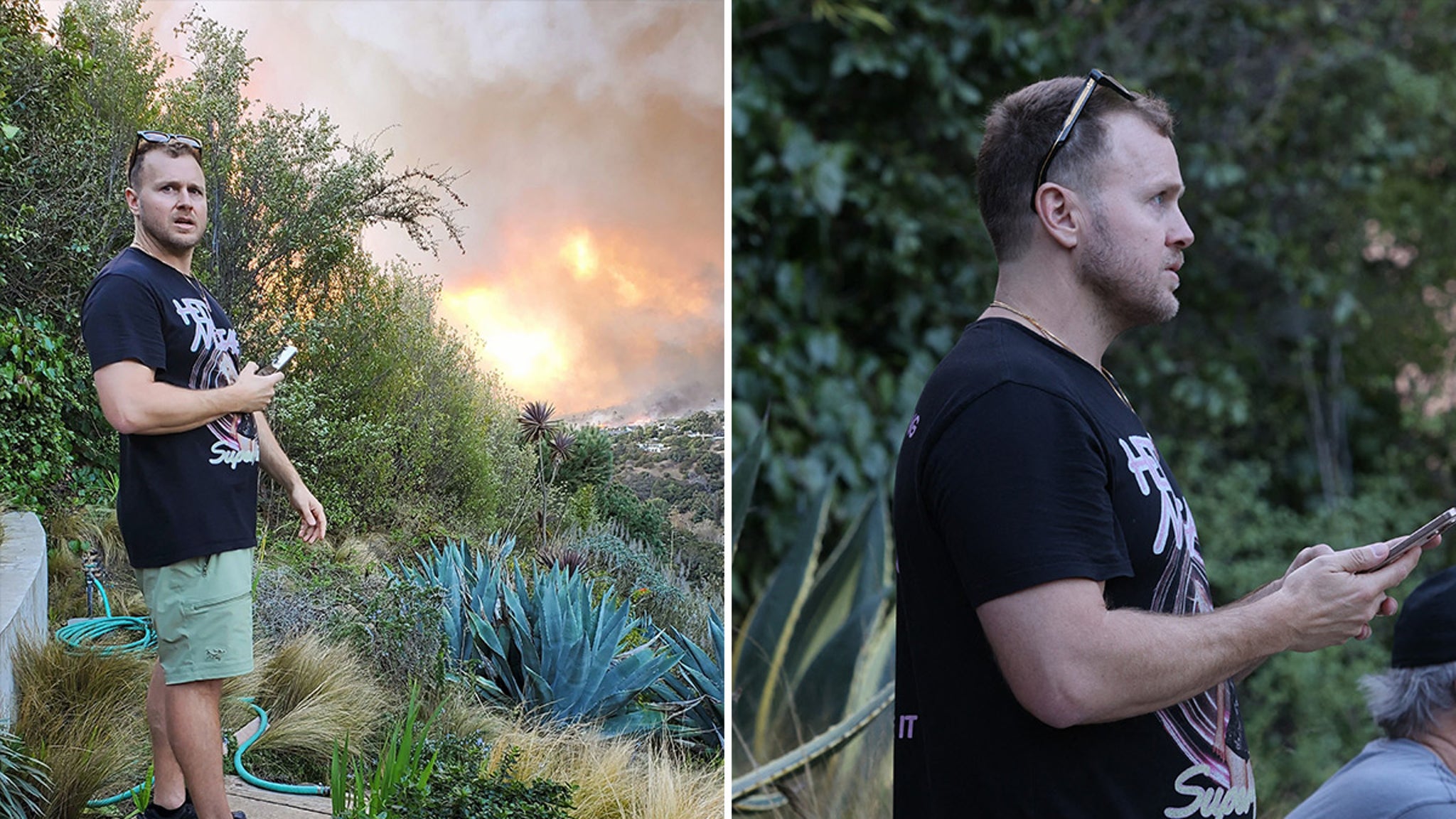Lifestyle
Spencer Pratt Breaks Down Realizing Family Is Starting From Zero After Wildfire
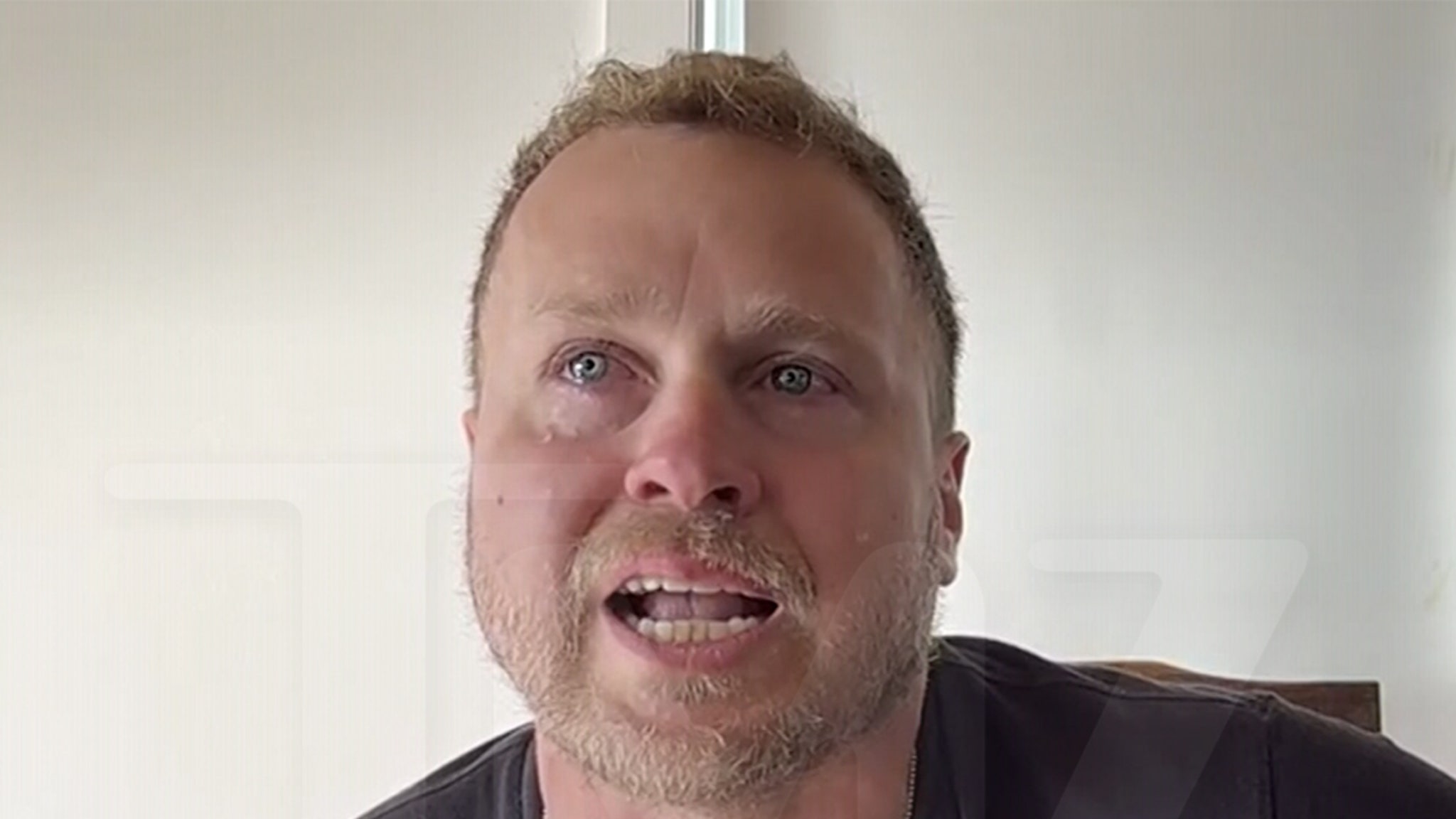
TMZ.com
Spencer Pratt says he feels like a ghost after losing everything he has in the Pacific Palisades wildfire … and the weight of starting life from zero and figuring out a way to provide for his family is hitting him hard.
The reality TV star joined us Monday on “TMZ Live” and he opened up to us about watching his life literally go up in smoke … and it’s emotional.
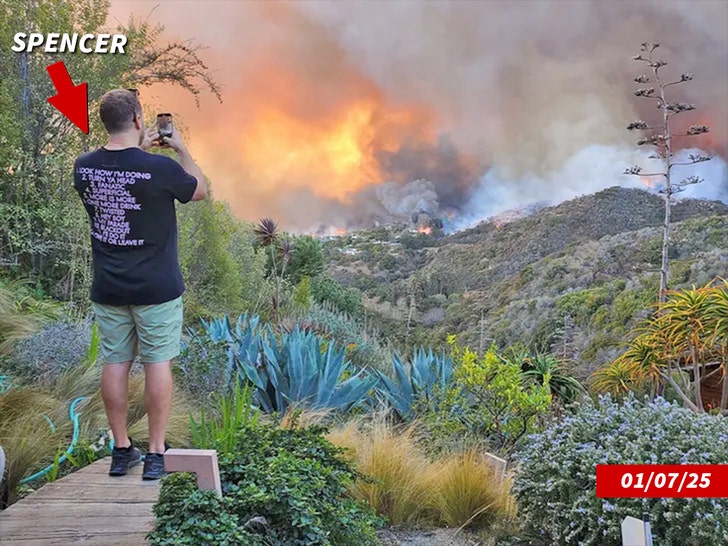
Spencer was born and raised in the Palisades and he says losing his house, all his possessions and his parents’ house makes him feel empty and hollow.
Ya gotta see our interview … Spencer’s holding it together at first, but the more he talks about the devastating fire that turned his life upside down, the dam breaks and the tears and emotion come pouring out.
Spencer’s back is against the wall as he tries to figure out a way to provide for his wife, Heidi Montag, and their 2 kids … and he says he’s up till 4 AM every night posting on social media to make a buck.
The only way Spencer’s able to keep his mind off the tragedy is by promoting Heidi’s 2010 album … and he’s doing a pretty good job, all things considered … her single “Superficial” is currently sitting atop the iTunes charts.

Spencer’s hoping they can scrape together enough money off the song’s renewed success to buy a new home for themselves and his parents, who also lost everything.
Spencer tells us he never thought something like this would ever happen to him … saying the devastating 2023 Maui wildfires felt like a world away … and he explains why enrolling his son in a new school made him feel like he was in a movie.
TikTok / @heidimontag
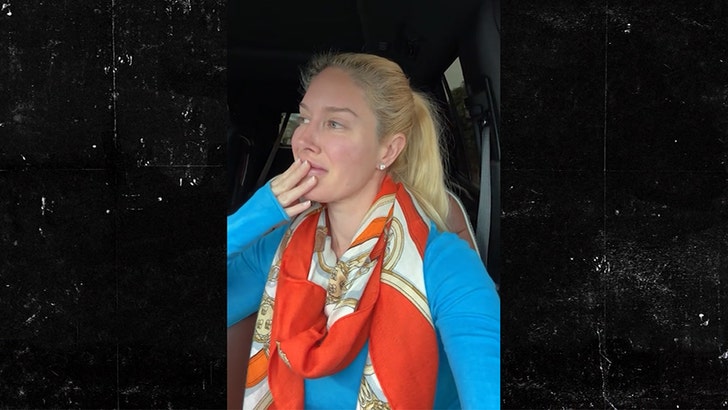
Lots of folks in L.A. are going through the same issues right now … so our conversation is a look into the lives of folks who lost everything in the blink of an eye.
The full interview airs today on “TMZ Live.”

Lifestyle
Oliviero Toscani, Driving Force Behind Provocative Benetton Ads, Dies at 82

Oliviero Toscani, an Italian photographer who used images of an AIDS patient and death row inmates to break the boundaries of fashion imagery as the creative mastermind of Benetton’s advertising campaigns, died on Monday. He was 82.
His death was announced by his family on Instagram. They did not say where he died or cite a cause of death, but in August Mr. Toscani told the Italian newspaper Corriere della Sera that he had been diagnosed with amyloidosis, a rare and incurable condition in which there is a buildup of protein.
His shock-and-awe campaigns in the 1980s and ’90s helped turn Benetton from a small Italian brand into a global fashion powerhouse, with provocative advertisements that blurred the lines between marketing and activism, high art and consumer industry.
In one ad, an AIDS patient lay on his back, his mouth open, his hands curled on his chest. His dark eyes stared past his family, who had gathered around his deathbed. The patient, David Kirby, looked almost Christ-like.
And there, near the bottom right, a few words hung in a green box: “United Colors of Benetton.”
The advertisement, which ran in the 1990s, was one of the most provocative and divisive in recent fashion history, prompting furious debates over whether Benetton, and Mr. Toscani, were creating art, engaging in advocacy or exploiting the epidemic to sell its clothes.
Notably, Mr. Toscani had the Kirby family’s permission to use a colorized version of the image, which was shot in 1990 by the photographer Therese Frare. The Kirbys said the campaign had helped broaden awareness about AIDS.
“Benetton didn’t use us, or exploit us,” the Kirby family said, maintaining that this was a way for their son’s portrait to be “seen all over the world, and that’s exactly what David wanted.”
Mr. Toscani’s ads were often socially progressive, with images of racially diverse and gay families. They were also meant to shock. He used pictures of horses copulating. He used the bloodstained uniform of a soldier killed in Bosnia-Herzegovina. One ad featured actors dressed as a priest and a nun kissing.
“Advertising agencies make millions by repeating the same old thing,” he told The New York Times in 1995, adding, “We try to go another way.”
Mr. Toscani sometimes crossed the line even for Benetton. He joined the company in 1982 and left in 2000 amid an uproar over an ad campaign that featured photographs of death row inmates across the United States.
He returned as creative director in 2017. But his career at Benetton came to an end in 2020, not because of the calculated and daring risks he had taken in photography and advertising, in which he delighted in his broadside challenges to conventional ideas of respectability. Rather, it was because of an offhand comment he made in a radio interview about a bridge collapse in Italy in which more than 40 people died. “Who cares that a bridge collapsed?” he had said. Though he apologized, Benetton fired him.
Italian politicians and creative leaders honored him in social media tributes on Monday. The designer Valentino Garavani, the creator of Valentino, called him “a visionary who challenged the world through his lens.” The designer Giorgio Armani wrote that “the directness and visual impact of his language set a standard.”
Oliviero Toscani was born in Milan on Feb. 28, 1942. He followed in the footsteps of his father, Fedele Toscani, a photojournalist. Mr. Toscani trained at the Zurich School of Applied Arts and worked as a fashion designer before he joined the Benetton Group as art director in 1982.
His survivors include his wife, Kirsti Moseng Toscani, and their three children, Rocco, Lola and Ali. Mr. Toscani was married twice before and had three other children. Complete information on survivors was not immediately available.
In his final months, Mr. Toscani told the Corriere della Sera that he had lost weight while being treated for amyloidosis and that his sense of taste had declined. Wine tasted different to him, he said. “I am not interested in living like this,” he added.
But in September, he traveled to the Museum fur Gestaltung Zurich for a major retrospective of his work called “Oliviero Toscani: Photography and Provocation.” It closed just over a week before he died.
“I have found out that advertising is the richest and most powerful medium existing today,” he told The Times in 1991. “So I feel responsible to do more than to say, ‘Our sweater is pretty.’”
Elisabetta Povoledo and Matthew Mpoke Bigg contributed reporting.
Lifestyle
Paradise lost along Pacific Coast Highway
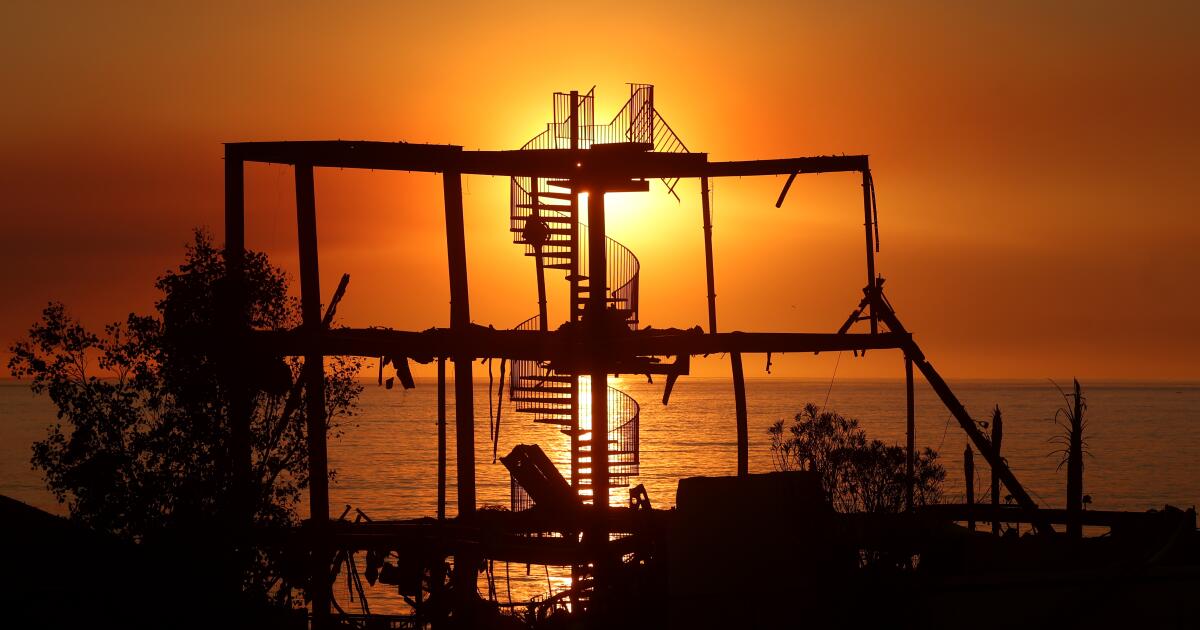
Everyone knows California is disaster-prone, but there’s a familiar logic to the calamitous geography in this high-maintenance beauty of a state.
Wildfires are supposed to be in the hills — in the wild — not on the beach, and certainly not inside the borders of one of the biggest and best-prepared cities on the planet.
The devastation from the Palisades fire extends for miles along Pacific Coast Highway.
(Robert Gauthier / Los Angeles Times)
But the fire that tore through coastal urban Pacific Palisades this week was driven by the kind of unholy wind speeds typically confined to high mountain passes or the crest of the Sierra Nevada. Astonishing gusts of 70 to 80 mph blew all of those preconceived notions away.
“I never thought we’d have to evacuate, because we’re so far away from the mountains,” said Denise Weaver, who lives on a bluff overlooking dozens of burned houses on the Pacific Coast Highway. She struggled to find words to describe the tragedy, and the irony, of friends losing everything to fire on the edge of the world’s largest water source.
“We’re, like, 100 feet from the Pacific Ocean,” Weaver said. “It’s just nuts.”
What amounted to a flaming hurricane erased all of the presumed safety advantages of fighting a fire in a well-equipped city.
The small air force of nearby tanker planes and helicopters was grounded. Powerful streams of water from a veritable traffic jam of firetrucks were snatched by the wind and carried away as mist. And with so much sudden demand on the city’s water system, hydrants quickly ran dry.
At that point, all of the affluence, urbanity and privilege in the world wasn’t much good. Desperate residents might as well have been alone on a remote, flaming mountainside.
“Fires under those conditions are essentially unfightable,” said UCLA climate scientist Daniel Swain. “The best you can hope to do is get people out of the way.”
To understand what made Tuesday so shocking, so confidence-shattering, think of wind like flowing water. In the usual Santa Ana storms, most of that flow streams out of the desert, through mountain passes and into the valleys along predictable pathways, like water coursing down riverbeds.
To the north, the strongest winds flow through the Newhall Pass, in Santa Clarita, and into the San Fernando Valley.
In the center, they flow down along the Santa Ana River — for which these storms are named — past Riverside and Anaheim on the way to the coast.
To the south, the wind comes through the Cajon Pass, between the San Bernardino and San Gabriel Mountains.
But on Tuesday, there was so much wind high in the atmosphere that it all just flooded over the tops of the mountains and came crashing down into the valleys like a massive wave against the shore.
It was “geophysically chaotic”, Swain said. “You didn’t just need to be in those gaps between the mountains to get the strongest winds.”
Then, just like a tidal wave, it went everywhere. In this case, it literally bounced over the Santa Monica Mountains — Swain called it a “hydraulic jump” — and crashed down along the coast of western Los Angeles County, straight into Pacific Palisades.
There have been windstorms like this before, including one in 2011 that caused a lot of wind damage in the San Fernando Valley, Swain said. But, fortunately, they didn’t spark catastrophic fires.
On Tuesday, the city wasn’t so lucky.
By Thursday, neighborhoods still smoldered for miles up and down the Pacific Coast Highway, more than 5,000 homes and businesses scorched. Residents, desperate to see what had become of their homes, argued with cops who had been ordered to keep people out of the evacuation zone.
It was a scene reminiscent of the aftermaths of so many other tragic fires — the Camp fire in Butte County in 2018, the Lahaina fire on Maui in 2023 — but this time the landscape seems oddly familiar, even for people who have never actually been to the Palisades.
That’s because, for anyone who grew up in the Midwest or on the East Coast absorbing images of California served up by shows such as “Baywatch” and films such as “Point Break,” this was the Los Angeles of their dreams.
A slow, sad drive up the coast on Thursday revealed so much of that familiar territory reduced to ashen ruins.
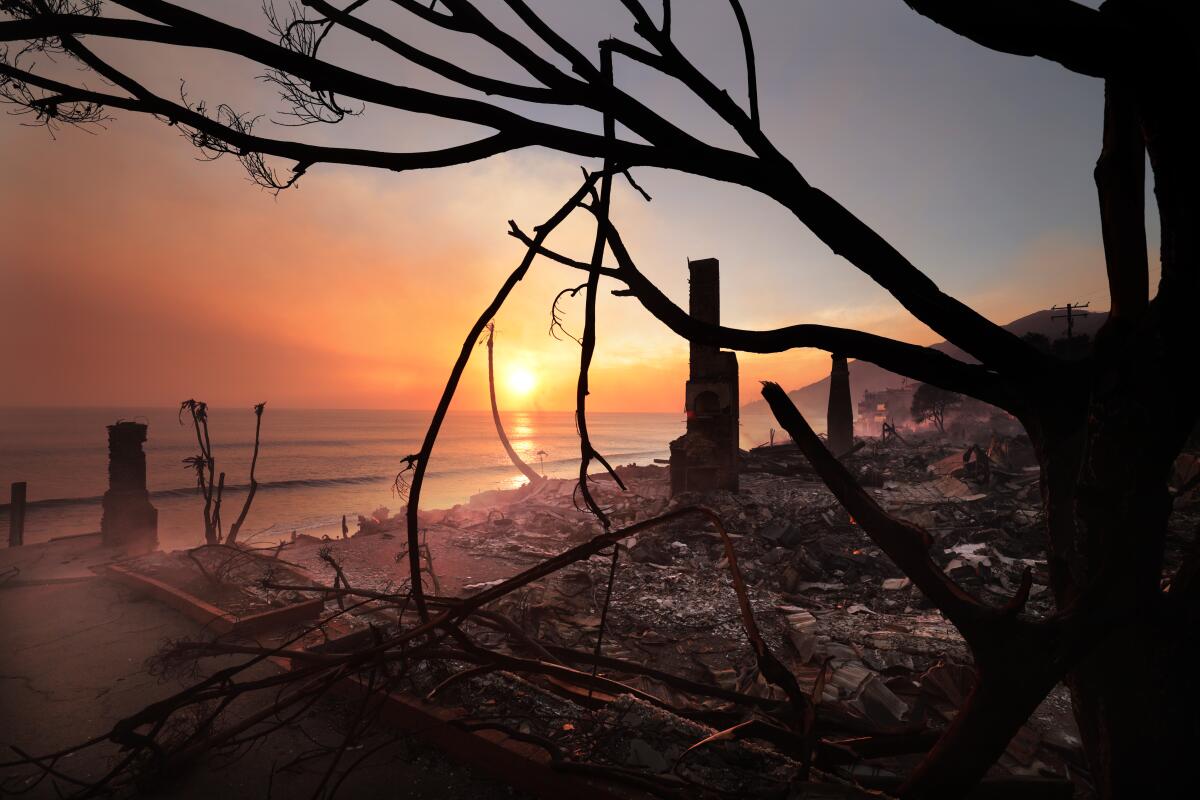
The ruins of beachfront homes smolder along the Pacific Ocean.
(Wally Skalij / Los Angeles Times)
Remember Moonshadows, the restaurant perched over the Pacific where Mel Gibson got drunk in 2006 and launched into a nearly career-ending anti-Jewish tirade when police pulled him over just down the road?
Gone.
So is Gibson’s $14-million house in Malibu, burned while he was in Austin, Texas, doing Joe Rogan’s podcast. “Well, at least I haven’t got any of those pesky plumbing problems anymore,” he quipped to the Hollywood Reporter.
Paris Hilton, Billy Crystal and Jeff Bridges — who played the title role in “The Big Lebowski,” a classic film in which Los Angeles’ Westside is arguably the real star — all lost their homes, too.
And that chubby-cheeked guy all over social media, bathed in an apocalyptic orange haze and pleading with people to leave their keys in their cars when they abandon them so he could move them to let firetrucks through, that was actor Steve Guttenberg from all those “Police Academy” movies in the 1980s.
How L.A. is that?
That “is this real, or a movie” sensation persists, even while you’re sucking in the acrid air and rubbing the ash out of your reddened eyes, as aerial tankers skim water off the ocean and lumber into the sky overhead. It feels like the set of a disaster film.
It gets real again, quickly, when a regular guy comes shuffling down Temescal Canyon Road in a Dodgers hat, N95 mask and dusty surgical scrubs.
Paul Austin, 61, is an orthodontist. He’d left at 6 a.m. Tuesday to go to his office in Simi Valley and straighten a few teeth. While he was gone, his home of 20 years and almost everything in it was “totally, totally destroyed,” he said. He hadn’t changed clothes in three days.
He started the interview joking that the only thing left on his property is a giant Santa in his frontyard, a holdover Christmas decoration that he thought for sure would have blown away.
“I don’t think for any of us, really, it’s even hit home what we’ve lost,” he said, and then he paused, overcome by sudden sobs behind his mask and his goggles.
“Everything.”
Lifestyle
Street Style Trend of the Week: Layered Hats

Nathalie Joseph, left, and Christel Jean-Pierre were scouting locations for a photo shoot in Washington Square Park on a Saturday in December when they caught my eye with their layered head gear.
Ms. Joseph, a 19-year-old model, had a black scarf draped over her camouflage baseball hat. Ms. Jean-Pierre, a 21-year-old model and aspiring director, had a striped reddish-orange beanie that recalled a tiger’s coat peeking out from beneath a green ribbed balaclava.
“I enjoy playing with colors and textures that reflect both my personality and the energy of the moment,” Ms. Jean-Pierre said when asked about her style. Ms. Joseph described the scarf atop her hat as “the cherry on top” of her outfit — and a way to keep warm without earmuffs. “It completes my look,” she said.
-

 Politics1 week ago
Politics1 week agoWho Are the Recipients of the Presidential Medal of Freedom?
-

 Health1 week ago
Health1 week agoOzempic ‘microdosing’ is the new weight-loss trend: Should you try it?
-
/cdn.vox-cdn.com/uploads/chorus_asset/file/25822586/STK169_ZUCKERBERG_MAGA_STKS491_CVIRGINIA_A.jpg)
/cdn.vox-cdn.com/uploads/chorus_asset/file/25822586/STK169_ZUCKERBERG_MAGA_STKS491_CVIRGINIA_A.jpg) Technology5 days ago
Technology5 days agoMeta is highlighting a splintering global approach to online speech
-

 Science3 days ago
Science3 days agoMetro will offer free rides in L.A. through Sunday due to fires
-
/cdn.vox-cdn.com/uploads/chorus_asset/file/25821992/videoframe_720397.png)
/cdn.vox-cdn.com/uploads/chorus_asset/file/25821992/videoframe_720397.png) Technology6 days ago
Technology6 days agoLas Vegas police release ChatGPT logs from the suspect in the Cybertruck explosion
-

 Movie Reviews1 week ago
Movie Reviews1 week ago‘How to Make Millions Before Grandma Dies’ Review: Thai Oscar Entry Is a Disarmingly Sentimental Tear-Jerker
-

 News1 week ago
News1 week agoTrump Has Reeled in More Than $200 Million Since Election Day
-

 Movie Reviews1 week ago
Movie Reviews1 week agoMovie Review: Millennials try to buy-in or opt-out of the “American Meltdown”
